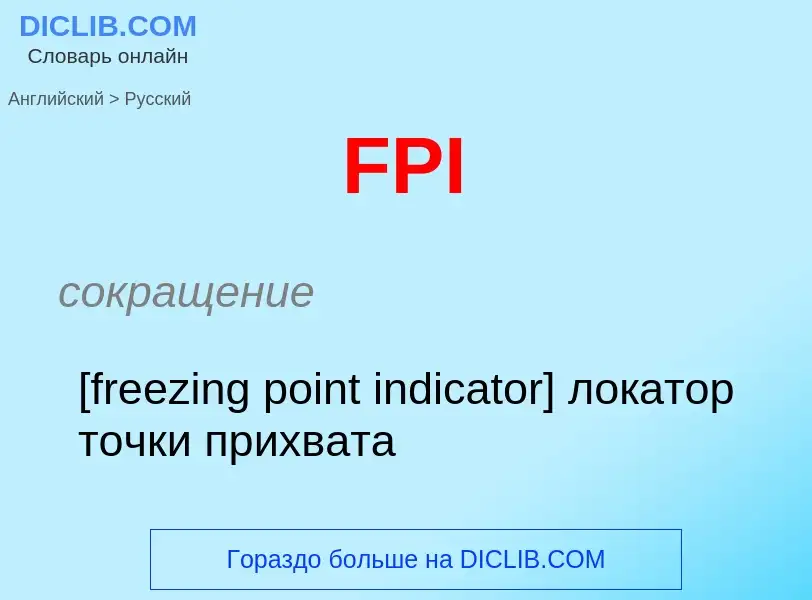Enter a word or phrase in any language 👆
Language:
Translation and analysis of words by ChatGPT artificial intelligence
On this page you can get a detailed analysis of a word or phrase, produced by the best artificial intelligence technology to date:
- how the word is used
- frequency of use
- it is used more often in oral or written speech
- word translation options
- usage examples (several phrases with translation)
- etymology
FPI - translation to russian
WIKIMEDIA DISAMBIGUATION PAGE
FPI (disambiguation)
FPI
CHEMICAL COMPOUND
Cyclopentadienyliron dicarboxyl iodide; CpFe(CO)2I; FpI; C7H5FeIO2
сокращение
[freezing point indicator] локатор точки прихвата
etalon
AN OPTICAL INTERFEROMETER MADE FROM TWO PARALLEL MIRRORS
Etalon; Fabry-Perot; Fabry-Perot Interferometer; Fabry-Perot Étalon; Fabry-Perot interferometer; Fabry-Perot etalon; Fabry-Perot étalon; Coefficient of Finesse; Coefficient of finesse; Fabry-Pérot etalon; Fabry perot etalon; Fabry Perot etalon; Fabry-Perot Etalon; Étalon; Fabry-Pérot étalon; Fabry-Pérot; Fabry Pérot etalon; Fabry Pérot étalon; Fabry Perot; Fabry Pérot; Fabry-Pérot interferometer; Fabry–Perot interferometer; Fabry–Pérot interferometers; Fabry-Perot device; Fabry–Perot etalon; Fabry–Pérot etalon; Fabry–Pérot; Fabry–Pérot laser; Fabry-Perot laser; Fabry-Pérot laser; Fabry-Pérot interferometers; Faby-Perot filter; Fabry-Perot filter; Fabry–Pérot interferometry; Finesse Coefficient; Fabry-Pérot interferometry; Fabry Pérot interferometer
общая лексика
эталон
эталонный
Fabry-Perot interferometer
AN OPTICAL INTERFEROMETER MADE FROM TWO PARALLEL MIRRORS
Etalon; Fabry-Perot; Fabry-Perot Interferometer; Fabry-Perot Étalon; Fabry-Perot interferometer; Fabry-Perot etalon; Fabry-Perot étalon; Coefficient of Finesse; Coefficient of finesse; Fabry-Pérot etalon; Fabry perot etalon; Fabry Perot etalon; Fabry-Perot Etalon; Étalon; Fabry-Pérot étalon; Fabry-Pérot; Fabry Pérot etalon; Fabry Pérot étalon; Fabry Perot; Fabry Pérot; Fabry-Pérot interferometer; Fabry–Perot interferometer; Fabry–Pérot interferometers; Fabry-Perot device; Fabry–Perot etalon; Fabry–Pérot etalon; Fabry–Pérot; Fabry–Pérot laser; Fabry-Perot laser; Fabry-Pérot laser; Fabry-Pérot interferometers; Faby-Perot filter; Fabry-Perot filter; Fabry–Pérot interferometry; Finesse Coefficient; Fabry-Pérot interferometry; Fabry Pérot interferometer
оптика
интерферометр Фабри-Перо
Examples of use of FPI
1. "The FPI declares it is pulling out of the peace process and declares its refusal to continue for much longer in a recolonization process overseen by the U.N.," FPI party president Pascal Affi N‘Guessan said.
2. The Ivorian Popular Front (FPI) accused the international community of carrying out a "constitutional coup d‘etat". Its leader, Pascal Affi N‘Guessan, said the seven FPI ministers would withdraw from the government of national unity set up under UN auspices.
3. Maksuni, an FPI deputy leader, told reporters after the protests: «This is not the last warning.
4. Verbal clashes between the groups escalated after FPI gangs forced former President Abdurrahman Wahid to leave a stage.
5. Recently, the FPI was one of several hard–line groups to condemn suicide bombings, distancing themselves from JI.








![Lorentzian linewidth and finesse versus Airy linewidth and finesse of a Fabry–Pérot resonator.<ref name=IsmailPollnau2016/> [Left] Relative Lorentzian linewidth <math> \Delta \nu_c / \Delta \nu_{\rm FSR} </math> (blue curve), relative Airy linewidth <math> \Delta \nu_{\rm Airy} / \Delta \nu_{\rm FSR} </math> (green curve), and its approximation (red curve). [Right] Lorentzian finesse <math> \mathcal{F}_c </math> (blue curve), Airy finesse <math> \mathcal{F}_{\rm Airy} </math> (green curve), and its approximation (red curve) as a function of reflectivity value <math> R_1 R_2 </math>. The exact solutions of the Airy linewidth and finesse (green lines) correctly break down at <math> \Delta \nu_{\rm Airy} = \Delta \nu_{\rm FSR} </math>, equivalent to <math> \mathcal{F}_{\rm Airy} = 1 </math>, whereas their approximations (red lines) incorrectly do not break down. Insets: Region <math> R_1 R_2 < 0.1 </math>. Lorentzian linewidth and finesse versus Airy linewidth and finesse of a Fabry–Pérot resonator.<ref name=IsmailPollnau2016/> [Left] Relative Lorentzian linewidth <math> \Delta \nu_c / \Delta \nu_{\rm FSR} </math> (blue curve), relative Airy linewidth <math> \Delta \nu_{\rm Airy} / \Delta \nu_{\rm FSR} </math> (green curve), and its approximation (red curve). [Right] Lorentzian finesse <math> \mathcal{F}_c </math> (blue curve), Airy finesse <math> \mathcal{F}_{\rm Airy} </math> (green curve), and its approximation (red curve) as a function of reflectivity value <math> R_1 R_2 </math>. The exact solutions of the Airy linewidth and finesse (green lines) correctly break down at <math> \Delta \nu_{\rm Airy} = \Delta \nu_{\rm FSR} </math>, equivalent to <math> \mathcal{F}_{\rm Airy} = 1 </math>, whereas their approximations (red lines) incorrectly do not break down. Insets: Region <math> R_1 R_2 < 0.1 </math>.](https://commons.wikimedia.org/wiki/Special:FilePath/Linewidth and finesse of a Fabry-Perot interferometer.png?width=200)



